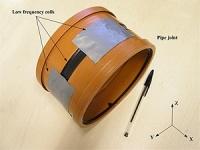The technology is a response to the growing levels of plastic being used in the utility infrastructure to replace older, degrading metal pipes. The group estimates that there is currently 4 million kilometres of buried pipes and cables in the UK, of which 100,000km is in need of replacement.
‘The pipes in the ground at the moment are quite difficult to detect because existing methods are either too expensive or ineffective,’ said Rakesh Roshan, a project manager at Oxford University’s technology arm, Isis Innovation. ‘Our device has a high level of accuracy and we expect it to reduce the cost of street works by at least 40 per cent.’
OXEMS’ solution uses a combination of radio-frequency identification and detection (RFID), and passive low-frequency tags that are attached to individual pieces of buried plastic pipe. These tags act as a barcode and, when scanned from surface, are able to provide information about the pipe’s location, its function and its state of health.

Kevin Gooding, chief executive of OXEMS, said: ‘One of the major benefits to utility firms of the OSEMS solution is that the ’intelligent’ part of the technology is on the surface, so that the buried tagging units are simple, leading to significantly reduced unit costs, as well as increased reliability and longevity.’
Roshan added that the technology could be used in other applications, such as identifying contaminates in the water supply or detecting cracks in cement. Talks are currently underway with two major utilities and the technology is expected to be commercialised in the near future.





Project to investigate hybrid approach to titanium manufacturing
Sadly they will not be ordering any more presses from Wilkins & Mitchell http://www.historywebsite.co.uk/articles/Darlaston/WM.htm